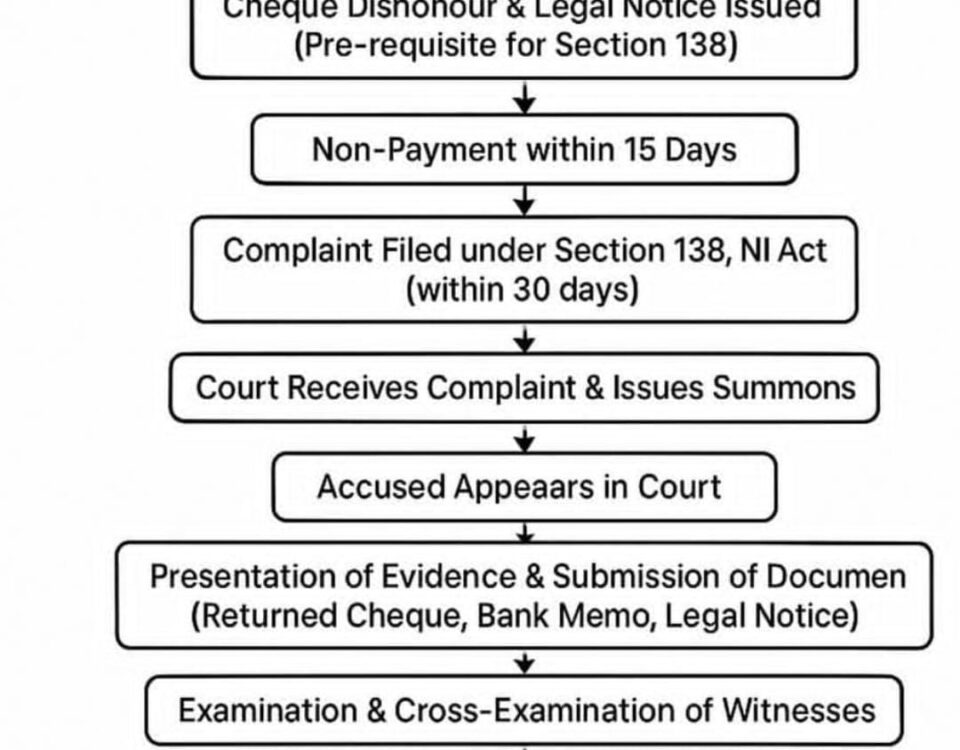- Top-rated Best Lawyer in Noida
- +91 96161-66166
- [email protected]

Understanding Matrimonial Cases: A Guide for Beginners
January 30, 2025
Criminal Cases Proceeding & Steps Involved in India
February 1, 2025A Detailed Exploration of the Civil Cases Process
Civil cases are legal disputes between individuals, businesses, or organizations where one party seeks a legal remedy, such as compensation, the enforcement of rights, or resolution of a conflict, through the court system. These cases deal with a wide range of issues, including but not limited to, breach of contract, property disputes, personal injury claims, and family law matters. Civil law aims to provide a framework for resolving non-criminal disputes, ensuring that individuals and entities can seek justice in a fair and impartial manner.
Key Stages of a Civil Case
Civil cases generally proceed through several stages, each of which involves specific steps and processes. The duration of a civil case can vary considerably depending on the complexity of the issues, the number of parties involved, and whether the case proceeds to trial. Below is an in-depth explanation of the key stages of a civil case:
1. Filing a Complaint/Petition: The initial step in any civil case is for the plaintiff to file a formal complaint or petition with the court. This legal document outlines the nature of the dispute, the specific claims being made, and the relief or remedy the plaintiff is seeking. The complaint must clearly explain the allegations, establish the legal basis for the claims, and include facts that support the plaintiff's case. Additionally, the complaint will outline the defendant's actions that allegedly caused harm or injury. The plaintiff must ensure that the complaint is legally sound and complies with the court's rules to avoid potential dismissal or delays.2. Service of Process: After the complaint is filed, the defendant must be formally notified about the lawsuit. This is known as the "service of process." Service ensures that the defendant is aware of the legal proceedings and has the opportunity to respond to the allegations. The defendant will be served with a copy of the complaint, and a summons will be issued by the court. The service can be done personally, through mail, or in some cases, via publication, depending on the jurisdiction and the circumstances. Once served, the defendant has a specified amount of time—typically 20 to 30 days—to file a response, or else the plaintiff may request a default judgment.
3. Defendant’s Response: Once the defendant has been served with the complaint, they must file a response, which can take several forms. In an answer, the defendant may admit, deny, or claim insufficient knowledge of the allegations made in the complaint. If the defendant denies the allegations, they may present defenses or legal justifications for their actions. Additionally, if the defendant believes that the plaintiff’s complaint fails to state a valid legal claim, they can file a motion to dismiss the case entirely. If a counterclaim exists—where the defendant believes the plaintiff is responsible for their own harm—the defendant may also file a counterclaim seeking damages or relief.
4. Discovery Phase: Discovery is a critical phase in civil litigation, designed to allow both parties to gather and exchange relevant evidence and information. This process can include written questions (interrogatories), document requests, and depositions, where both parties take sworn statements from witnesses under oath. Discovery allows each party to learn about the other side’s evidence and legal arguments, which can lead to the identification of weaknesses in the opponent’s case. Discovery can also result in the sharing of expert reports, photographs, videos, or other crucial materials that will be used to support or challenge claims in court. In some cases, discovery disputes may arise, requiring intervention by the court to compel the production of certain evidence.
5. Pre-Trial Motions: Before the case goes to trial, either party may file pre-trial motions, which seek to resolve specific issues in the case or request actions by the court. These motions might include requests for summary judgment, which argue that there are no material facts in dispute and that one party should win as a matter of law. A motion to dismiss may be filed if the party believes the case is legally insufficient. Pre-trial motions can also involve requests to exclude certain evidence or testimony that is deemed inadmissible, which can significantly affect the outcome of the trial. These motions are an important part of the litigation process, as they may resolve critical aspects of the case before the trial even begins.
6. Negotiation and Settlement: A substantial number of civil cases are resolved before they go to trial, through negotiation or settlement. In many instances, both parties recognize the benefits of reaching a mutually acceptable resolution rather than enduring the time, expense, and uncertainty of a trial. Settlement discussions can take place at any point during the litigation process—often after discovery but before trial. During settlement negotiations, the parties may be represented by their attorneys and may discuss potential settlement terms, which may involve monetary compensation or specific performance, such as an agreement to fulfill certain contractual obligations. Mediation and alternative dispute resolution (ADR) methods, such as arbitration, are often used to facilitate settlement discussions. If a settlement is reached, the parties will enter into a legally binding agreement, and the case will be closed without the need for a trial.
7. Trial: If a settlement is not reached, the case proceeds to trial. Trials are formal legal proceedings where both the plaintiff and defendant present their evidence, witness testimony, and legal arguments to a judge or jury. Trials can be either jury trials or bench trials, where the judge alone makes the final decision. In a jury trial, the jury determines the facts of the case, while the judge rules on legal issues and ensures that the trial is conducted fairly. The trial begins with opening statements, followed by the presentation of evidence, including documents, witness testimony, and expert opinions. After both sides have presented their cases, they make closing arguments, and the judge or jury deliberates and issues a verdict. The verdict will determine whether the defendant is liable and, if so, what damages or remedies should be awarded to the plaintiff.
8. Judgment: After the trial, the judge or jury will issue a final judgment. In civil cases, the judgment typically involves determining whether the defendant is liable for the claims made by the plaintiff. If the plaintiff wins, the court will assess the damages to which the plaintiff is entitled, which could include compensatory damages for actual losses, punitive damages for particularly egregious conduct, or equitable relief such as an injunction (court order requiring a specific action). The judgment may also outline other remedies, such as restitution, specific performance, or declaratory judgments, depending on the nature of the dispute. Once the judgment is rendered, the prevailing party can seek enforcement of the judgment, including garnishment of wages or seizure of property if the defendant fails to comply with the court's order.
9. Appeals: If either party is dissatisfied with the judgment, they may file an appeal to a higher court. Appeals are based on legal errors that occurred during the trial process, such as improper rulings on evidence or procedural mistakes. The appellate court does not re-examine the facts of the case but instead reviews the trial record to determine whether the law was applied correctly. If the appellate court finds that significant legal errors occurred, it may reverse the judgment, modify the verdict, or order a new trial. Appeals can extend the timeline of a case and add additional costs, but they provide a mechanism for correcting mistakes made by the trial court.
Have a question?
Ask the experts.
Marriage as an institution has undergone various changes and while it may turn out to be a life-long companionship for most, it simply is an excruciating ordeal for some. To accommodate the changing facets of the institution of marriage, the law has introduced amendments from time to time. Today, divorce is no longer a taboo and is rapidly being resorted to dissolve a marriage which no longer serves its purpose.
Write us a message
Get in touch
- LAWYER IN NOIDA
TS-1103, 11th Floor, Office Tower, Galaxy Blue Sapphire Plaza, Noida Extension, Greater Noida West, Uttar Pradesh-201308 (Near Gaur City Mall)
Types of Damages in Civil Cases
When a plaintiff wins a civil case, the court may award various types of damages to compensate the plaintiff for their losses, punish the defendant for wrongful conduct, or deter future violations. The types of damages awarded depend on the specific nature of the case and the harm suffered:
1. Compensatory Damages: Compensatory damages are awarded to compensate the plaintiff for actual losses incurred due to the defendant’s actions. These damages aim to restore the plaintiff to the position they were in before the harm occurred. In personal injury cases, compensatory damages may cover medical expenses, lost wages, and pain and suffering. In contract disputes, they may cover the cost of performance or the difference between what was promised and what was delivered.2. Punitive Damages: Punitive damages are awarded in exceptional cases where the defendant’s conduct was particularly malicious, willful, or egregiously reckless. These damages are meant to punish the defendant for harmful behavior and serve as a deterrent to others who may engage in similar actions. Unlike compensatory damages, punitive damages are not designed to make the plaintiff "whole" but to send a message that certain behaviors will not be tolerated.
3. Nominal Damages: Nominal damages are small amounts of money awarded when a plaintiff’s legal rights have been violated, but no substantial harm or financial loss has occurred. These damages serve as a recognition of the plaintiff’s legal rights and the wrong committed by the defendant. Nominal damages often serve as a precedent for other legal actions or claims.
4. Liquidated Damages: Liquidated damages are pre-determined amounts specified in a contract that both parties agree to in the event of a breach. These damages are set at the time of the contract's formation and are intended to provide certainty in case of a dispute. Liquidated damages can be a fixed amount or a formula based on the circumstances of the breach, and they help avoid lengthy litigation to determine the extent of harm.
5. Statutory Damages: Statutory damages are set by specific laws or statutes and are awarded regardless of the actual harm suffered by the plaintiff. These damages are often used in areas such as intellectual property law, including copyright infringement, where the law allows for a set amount of damages per violation. Statutory damages aim to provide an efficient and consistent remedy for violations of specific legal rights.
Civil cases are legal disputes between individuals, businesses, or organizations where one party seeks a legal remedy, such as compensation, the enforcement of rights, or resolution of a conflict, through the court system. These cases deal with a wide range of issues, including but not limited to, breach of contract, property disputes, personal injury claims, and family law matters. Civil law aims to provide a framework for resolving non-criminal disputes, ensuring that individuals and entities can seek justice in a fair and impartial manner.

